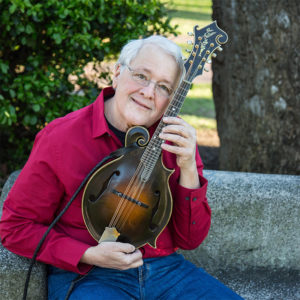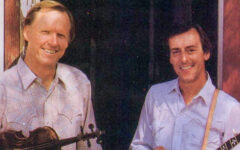
“Tony Williamson is among the finest mandolinists alive, and (his) instrumental passages…dazzle without ever lapsing into flashiness. This is great music!” So said David Ryoko of the Chicago Tribune in 2001.
Announced as a 2018 North Carolina Heritage Award recipient, Williamson, from Chatham County, is described as “a visionary musician, composer, musical instrument expert, teacher and mentor.” He blends multiple genres but still remains rooted in bluegrass.
Williamson’s father and grandfather, both millworkers, played the banjo in their leisure time and, since his older relatives already played guitar, fiddle and banjo, a young Tony Williamson decided to pick up the mandolin. Actually, his brother, Gary, was given a mandolin for his fifth birthday. “I was four and he told me not to touch it.” It doesn’t take much to imagine how Tony reacted to that instruction.
Over the next few years Tony and Gary both learned to play the guitar, fiddle and banjo. “When I was nine, my cousin took me to see Bill Monroe in person for the first time, and that is when I got really serious about the mandolin,” Tony Williamson explains.
Williamson went on to say of the impact that Monroe had on him …..
“When Monroe took the stage, all eyes were on him; the musicians took their cues from him and his regal presence was a revelation in terms of dignity and professionalism. And his mandolin playing absolutely blew my mind. Right then I started on a quest that I continue to this day!”
When he was only 15 years old he won the first-place “world champion” title for mandolin at the Union Grove Fiddlers Convention, North Carolina.
As part of The Bluegrass Gentlemen, set up by the two Williamson brothers, he won the First Place Band award at Union Grove.
Williamson has this to say of the creative juices that flowed freely as a youngster …..
“By the time we were teenagers, we were really kicking up some dust with fast picking, high harmonies and, as song writers, we began expanding the harmonic components of bluegrass at a time when most other bands rarely strayed from a three-chord formula.”
Three years later he met Monroe in person for the first time, and had his first experiences in a professional recording studio; the Williamson brothers recorded an instrumental version of John Henry for an anthology called Discovering Music Together.
Then in 1970, Williamson was selected to go to Governor’s School, a residential summer program for academically gifted high school students.
He says of his introduction to classical and jazz music …..
“It was like a whole new world opened up for me. There [was] this incredible library of all this stuff, and there are other kinds of music, and art and literature. And so I start[ed] writing some pretty cool things. I expanded the harmonic range so that I can include more than just a song, more than just a story…but an actual multi-dimensional feeling.”
During the early 1970s Williamson played with the likes of Earl Scruggs, Bill Monroe, and Bobby Hicks, as well as being a part of the Green Valley Ramblers, another group that featured his brother Gary.
Subsequently he performed classical music with Duke University Symphony, demonstrating how much of a mandolin virtuoso he had become.
Williamson shares his thoughts and his reaction to getting the news of his prestigious award ….
“The North Carolina Arts Council, which is celebrating 50 years of great works, has so many wonderful programs. Perhaps more than any, the North Carolina Heritage Award is extremely important to me personally, as they have honored so many of my heroes such as Earl Scruggs, Doc Watson, Bobby Hicks and George Shuffler. When Governor Roy Cooper’s office announced that I was one of this year’s recipients, I was overwhelmed with the very idea that I would be joining such distinguished ranks! It is a life time achievement award, and though they are celebrating my career in music, I am filled with new enthusiasm to up my game on every level, from performing to composing and recording. In conjunction with the ceremony and concert that took place on May 23, I released Heritage, an anthology of recordings beginning in 1968 and ending with tracks just finished.
Without doubt, I find myself incredibly grateful. My thanks go out to the North Carolina Arts Council and the North Carolina Department of Natural and Cultural Resources, as well as all the musicians, friends, family and especially fans of my music that have supported what I do. Also, I never go very far without paying homage to my many mentors in bluegrass such as Bill Monroe, Flatt and Scruggs, and The Stanley Brothers, just to name a few. I take this honor quite seriously, and pledge to do my very best to carry on the traditional music of my heritage and continue to take those traditions to loving audiences all over the world.”
When did you first take an interest in music / in bluegrass music, please?
“Music was a part of my family growing up, my dad and grandfather played banjo and fiddle and friends from within the community would gather for informal ‘pickings’ every Friday night. As early as the age of four I was loving the sounds I could make with a mandolin. When I was nine, my family took me to see Bill Monroe and at that point I became very serious.”
Who did you have to help your learning process?
“I never had lessons in terms of where to put the fingers on the mandolin neck and how to hold the pick and wrist. Almost everyone in my father’s music circle played banjo, fiddle or guitar, so there was no local mandolin hero. In the beginning, I was just sitting in the corner holding the mandolin while the adults played, largely ignoring me. After I saw Bill Monroe the first time, I went on a mission. With mostly borrowed 78 and 45 rpm ‘singles’ I began to digest the way he approached a break by trying to reproduce it on my mandolin as closely as possible. When those singles were returned they all had nasty scratches before and after each mandolin break, much to the chagrin of my cousin who had loaned them. So, with money I made by doing farm chores, I began to buy long-playing 33rpm vinyl records out of the 99 cent bin at Archie’s Records in Asheboro, North Carolina.
Interestingly, all the Bill Monroe music relegated to the budget labels at that time were the early recordings that had originally been released on RCA and Columbia, and featured either the Clyde Moody/Tommy Magness or Lester Flatt and Earl Scruggs versions of the Blue Grass Boys. The music that my brother and I played as teenagers had that sound. This was before Monroe had begun to ‘chop’ his mandolin, so the music had no backbeat, just all surging, driving rhythm with emphasis on beats one and four.
So really, to answer your question, my learning process was governed by the genius of Bill Monroe and the frugality of growing up on a farm in North Carolina!”
After graduating with highest honors from University of North Carolina in Chapel Hill, Williamson took a break from school to go on the road with the Bluegrass Alliance, whose alumni include Vince Gill, Sam Bush, and Tony Rice.
During the 1970s Williamson’s reputation as a stellar mandolin player grew, with him becoming even more in demand at festivals and for recording sessions, working with Sam Bush, David Grisman, Jerry Douglas, and Ricky Skaggs.
While out in California in 1978 he become a member of the Richard Greene Band.
In the early 1980s Williamson toured Europe with the Green Valley Ramblers and then had a brief stint with Courtney Johnson and Curtis Burch as part of the Barren County Revival.
In 1986 he formed a band with Craig Smith, Vernon Allred, and Scott Huffman, called ASH&W; Williamson is “W”. The quartet released one album – self-titled – on Rebel Records (CD 1686, released in 1990).
A series of accidents in the late 1980s left Williamson facing the possibility of never being able to play music again. At the same time as working hard to rebuild his strength he started Mandolin Central in Siler City, what is now an internationally renowned resource for vintage mandolins and guitars. Williamson acquired a Lloyd Loar mandolin after college and he has played it ever since.
During the years that followed those accidents, he sought relief through acupuncture and at an Ashram, a spiritual retreat, in Taiwan. As a result, not only was he able to play the mandolin free from any pain, he was able to mentor young up-and-coming musicians such as Chris Thile of Nickel Creek and the Punch Brothers.
Returning to his own music, Williamson recorded an album, Across the Grain (Plucked String PSD 005D, released in 1996) at Doobie Shea studios with all-star cast; Craig Smith, Jason Carter and Jerry Douglas. This album runs the gamut from bluegrass music to classical, to blues and jazz.
Other recording highlights of the 1990s are All for Naught (Mandolin Central MCP 0001, 1996) an album of solos on a variety of vintage mandolins and guitars, My Rocky River Home, (Mandolin Central MCP 003, 1998), a duet album with brother Gary, and Let Us Cross Over the River (Doobie Shea DS-CD 3003, 1999) a Gospel album with a full bluegrass band backing up Tony and Gary.
In the early part of the decade, Williamson played mandolin of two tracks including the title track, on Larry Perkins’ A Touch Of The Past album (Pinecastle PRC 1022, 1993). It won the IBMA’s Recorded Event of the Year award in 1994. He also appears on this album playing guitar, his first collaboration with fiddle legend Vassar Clements.
In 1996 he helped to organize the first MerleFest Mando Mania. In 2016 Williamson told the Indy Week about the origins of Mando Mania …….
“Mando Mania came out of a crazy idea I had at the Midnight Jam in 1996, twenty years ago. As you know, on Saturday night, at the Walker Center, an indoor auditorium, there is a late-running concert made up of musicians that do not normally play together. Seats are limited and only the brave folks willing to give up a night of sleep can attend. The audience gets to see some rare chemistry as old friends and new acquaintances team up.
I happened to have on hand an entire collection of mandolin-family instruments, including mandocello and mando-bass. I went around to all my mandolin picking buddies and invited them to join me at the jam. As an introduction, I first played a mandolin solo, Road To Pedro’s, that received a standing ovation. Then I said, ‘And now, for a bit of mania—mando mania, that is!’ And out they came to join me: Sam Bush, Tim O’Brien, as well as Radim Zenkl from Czech Republic. Don Wright played mandocello, Frank Greenhouse and Ralph McGee on mandola and John Cowan on mando-bass … a stage full of mandos! Oh what I would give for a video of that! There were, of course, no smart phones or YouTube in those days! The audience was on their feet and the ovations and encores went on and on.”
At the turn of the century Williamson released Still Light of the Evening (Mapleshade Records 08952, 2001), a collection of early bluegrass, fiddle tunes and some of his originals with help from brother Gary, Larry Perkins, Tom Gray and others. The 15 tracks were recorded using eclectic techniques at a studio in Maryland.
Then in April 2003 Williamson released the eclectic Sessions At McBane Mill (Bonfire BONF 8003) with Jeff Autry, Robbie Link, and Rex McGee. This album is filled with original instrumental compositions performed for the first time live at an old mill. With an inspired chemistry, the quartet runs through music that ranges from bluegrass to jazz.
For a couple of years in the mid-2000s he helped to organise the Low Country All-Star Band, fronted by Vassar Clements and Tony Rice. They released a CD Vassar Clements/Tony Rice & The Low Country All-Star Band (Flatt Mountain FMR 001) in June 2006.
Five years later came Lloyd Loar Mandolins (Mandolin Central 0065), a collection of solos on 13 different Gibson F-5 mandolins made in the 1920s. This CD showcases the subtle nuances and differences found in a collection of the world’s finest and most expensive mandolins.
Fast forward to this year, and on the back of the notification of his North Carolina Heritage Award, Williamson gathered together a dozen recordings from his illustrious 50-year recording career and did three new songs and an instrumental to complete the aptly-named Heritage album (Mandolin Central). 12 of the songs/tunes were written by Williamson, demonstrating another tool that he has in his locker.
During those 50 years he has played with the likes of Alison Krauss, Chris Thile, Earl Scruggs, Bobby Hicks, David Grisman, Sam Bush, Mike Marshall, Ricky Skaggs, Jerry Douglas, Don Stiernberg, and Robin and Linda Williams.
As well as playing in almost every state in the US, Williamson has made appearances in France, Ireland, Japan, Taiwan, Brazil, Peru, Canada and Italy.
The presentation of the North Carolina Heritage Award, of which there were five recipients, took place at the A J Fletcher Opera Theater, Duke Energy Center for the Performing Arts in Raleigh, North Carolina, this past Wednesday, May 23, 2018.
A big supporter of bluegrass musicians from her home state, Penny Parsons, the author of Foggy Mountain Troubadour (published in May 2016), attended the awards ceremony and shared these impressions of the event ….
“These awards ceremonies are always extremely well done. There is clearly a great deal of thought and effort put into the event by North Carolina Arts Council Executive Director Wayne Martin and his staff. Each honoree is featured in a short video that covers the highlights of his or her artistic endeavor, then the artist takes the stage and has an opportunity to speak and answer questions from Martin, then the recipient performs in the format of his choosing.”
Parsons graciously added her own praise for Williamson and a brief appreciation of the set that he played during the evening …
“I have known Randolph County mandolin player Tony Williamson for over thirty years and enjoyed watching him perform in numerous bands in a wide variety of settings. I’ve never known anyone who has pursued such a variety of life experiences and successfully incorporated those experiences into his music the way Tony has. His performance was a snapshot of this.
He began by performing a classically influenced instrumental that he wrote specifically for the occasion. He sang one of his bluegrass compositions, joined by his brother Gary and banjo playing friend Don Wright. He also featured 16-year-old tap dancer Jabu Graybeal on a couple of numbers.
Tony was accompanied by his son Hardy on guitar, his long-time associate Robbie Link on bass, banjoist Noam Pikelney, and fiddling sisters Caroline and Katherine Ririe, all of whom skilfully and tastefully navigated the series of musical styles at which Tony is so adept. The finale was a jazz extravaganza on which Tony and the band were joined by his fellow 2018 honoree Dick Knight and 2014 NC Heritage Award winner Bill Myers.
Tony Williamson is one of the unsung heroes of our music. He has been performing since childhood and has spent a lifetime studying music, musicians, instruments, and their history. This was never a job for Tony… it was and is his passion. He might have achieved wealth and fame as a touring musician, but he chose to stay close to his family and his North Carolina roots and to pursue his calling on his own terms. In so doing he has become world renowned and highly respected among mandolin aficionados and musicians in many genres. Equally as important, he has remained a loyal, caring, and supportive son, brother, father, husband, and friend through it all.”
And she didn’t forget fiddle player Arvil Freeman, another recipient of a North Carolina Heritage Award ….
“It was especially gratifying to see two traditional musicians receive the award this year. Madison County fiddler Arvil Freeman straddles the line between old-time and bluegrass music, having performed with the Sauceman Brothers, Marc Pruett and his own band, 40 West. He has dedicated many years to sharing his wealth of knowledge with aspiring young fiddle students.”
Congratulations to Tony Williamson for this richly deserved award.








